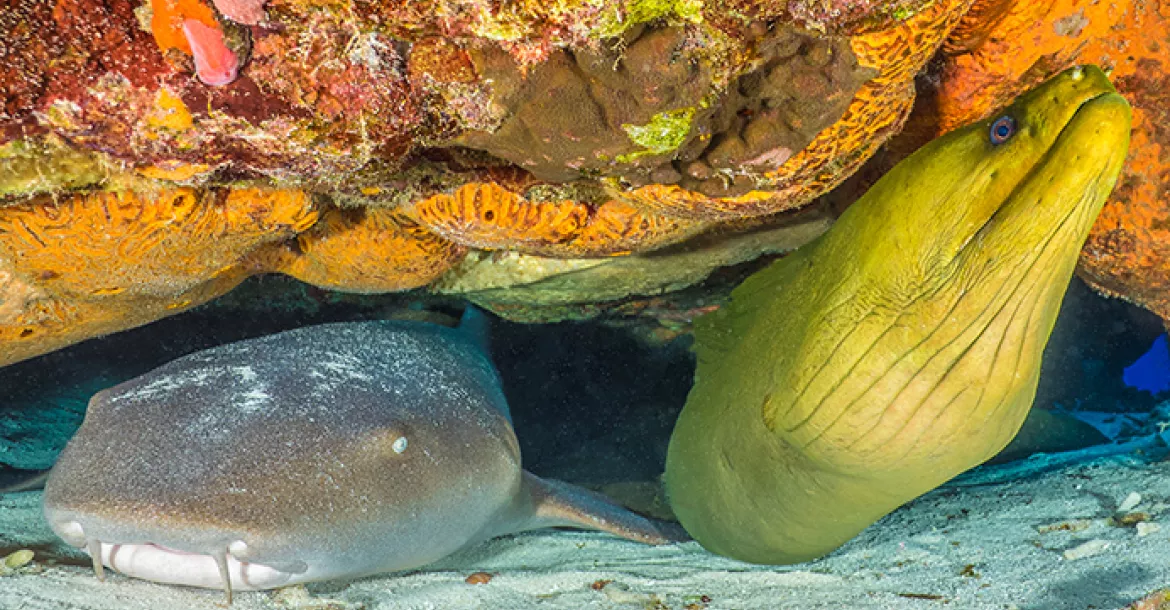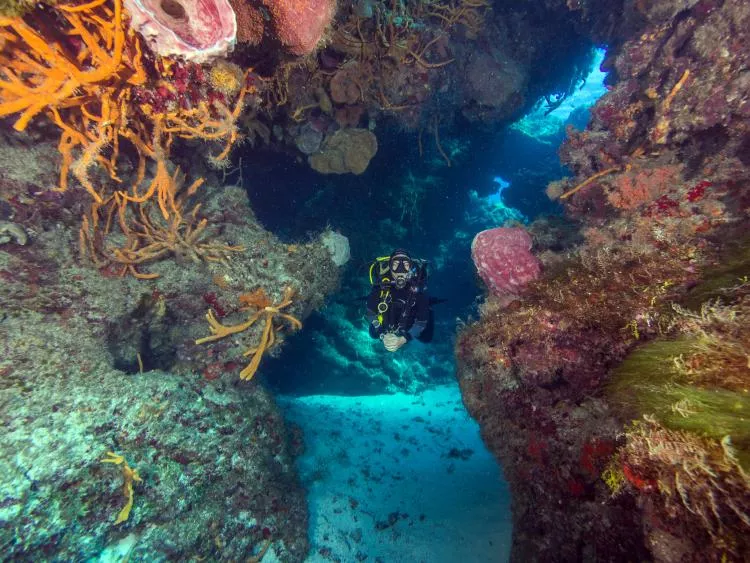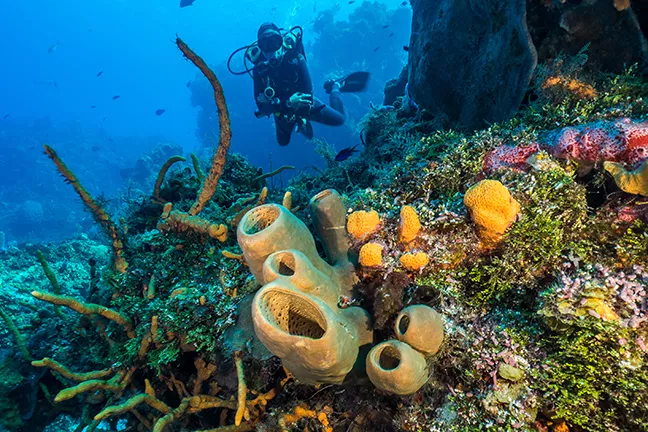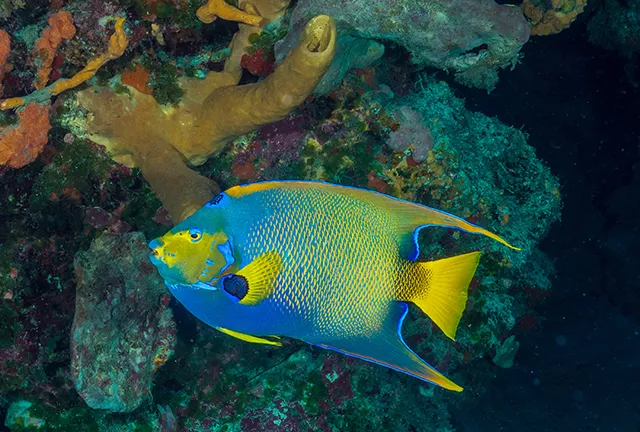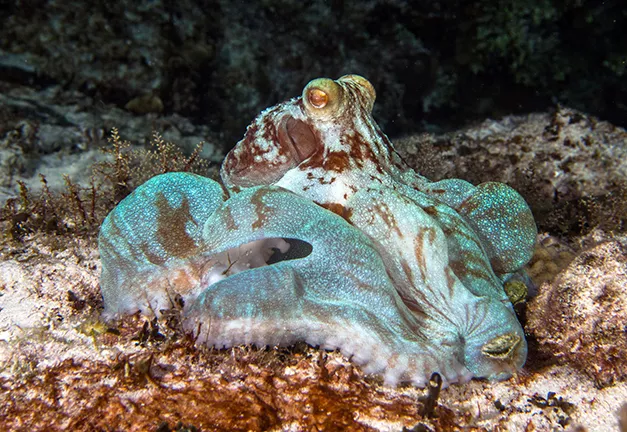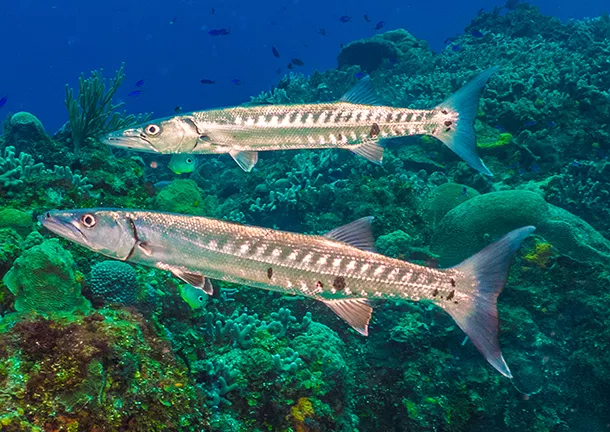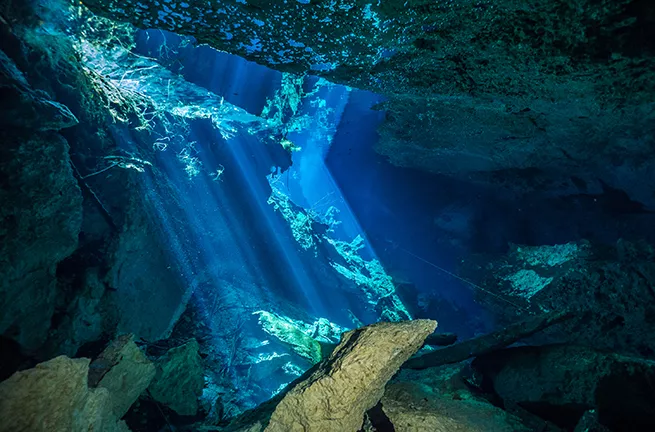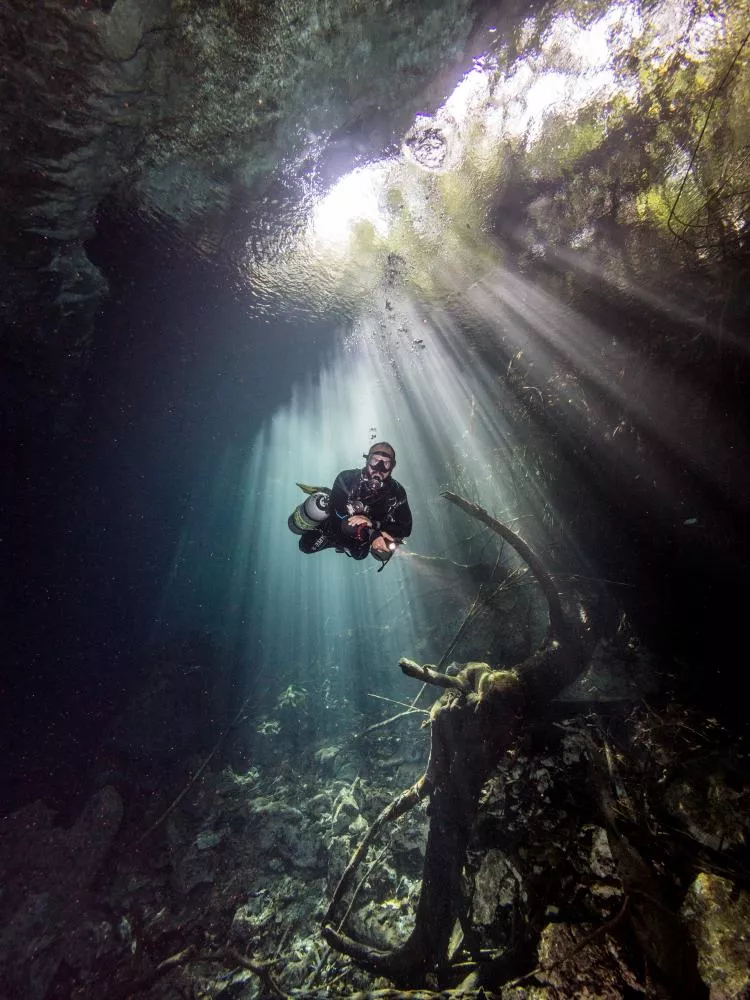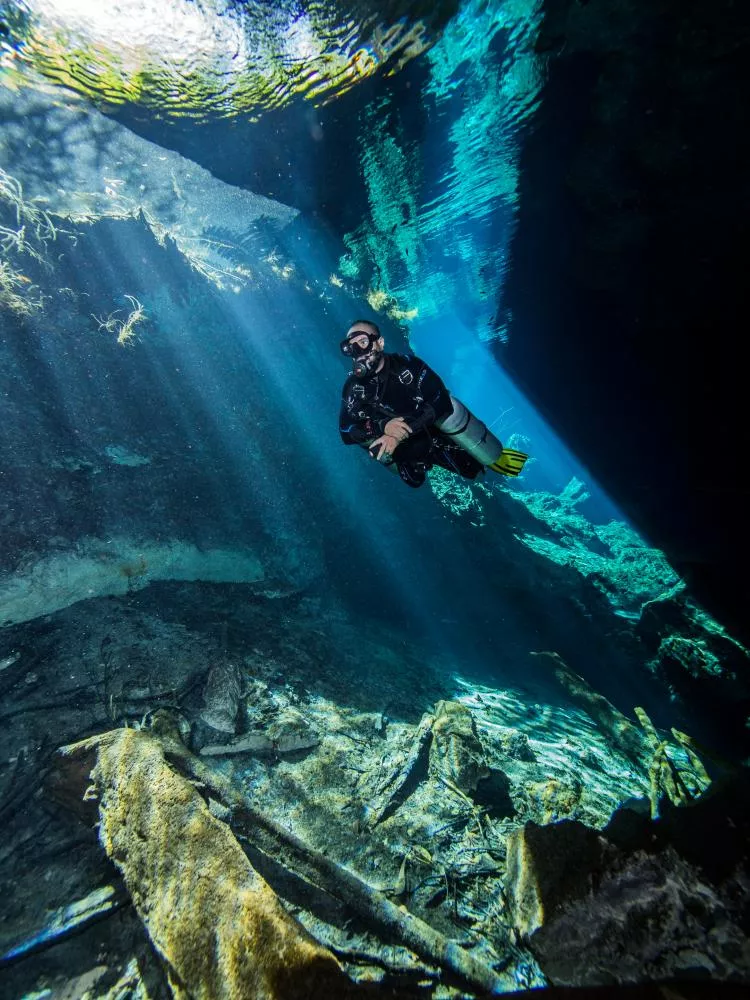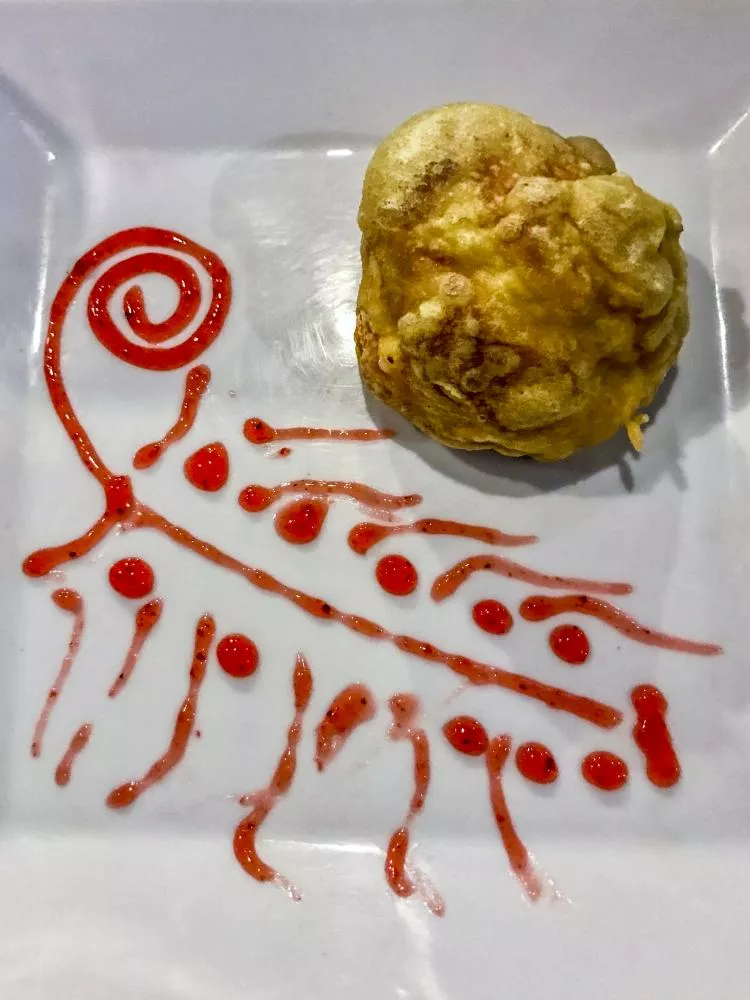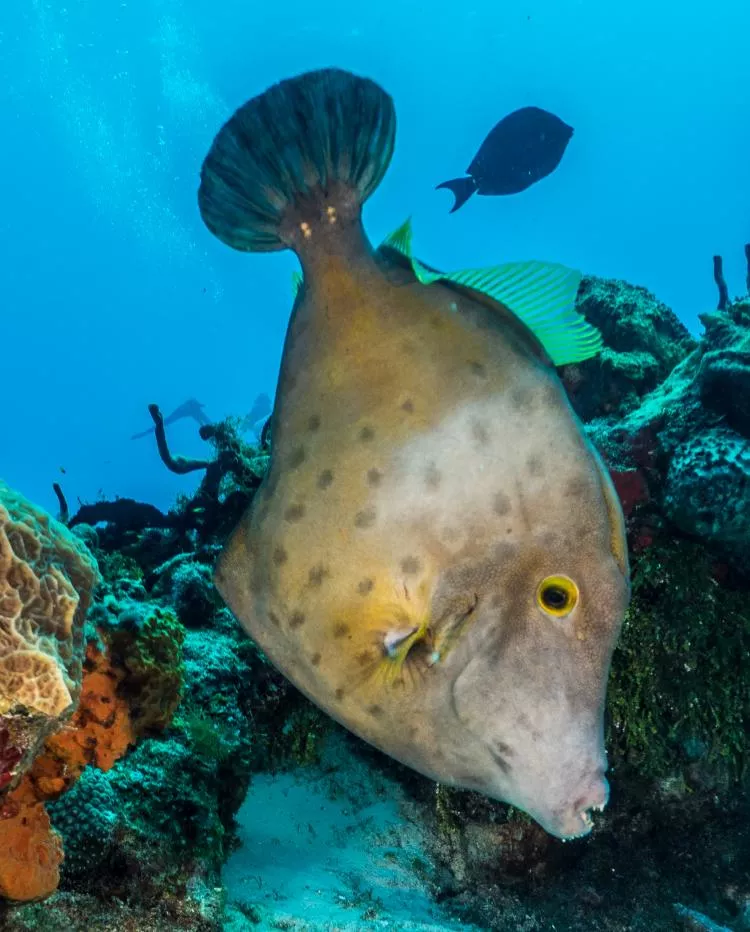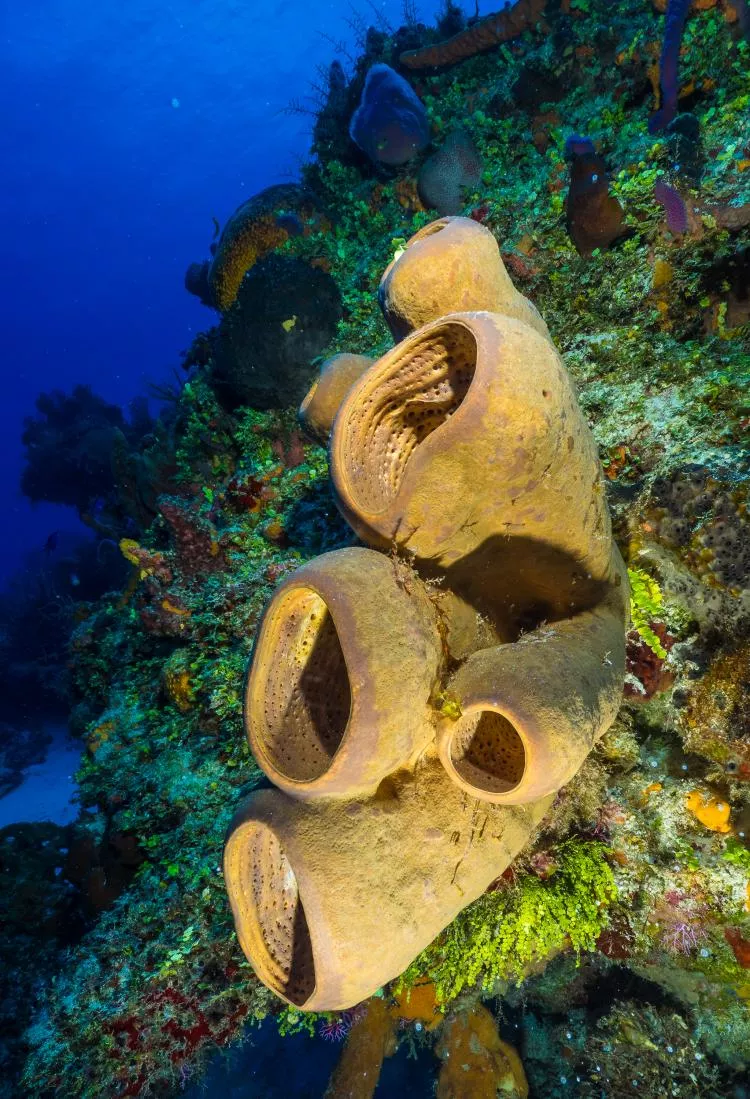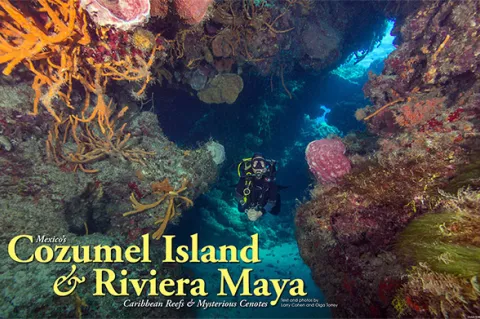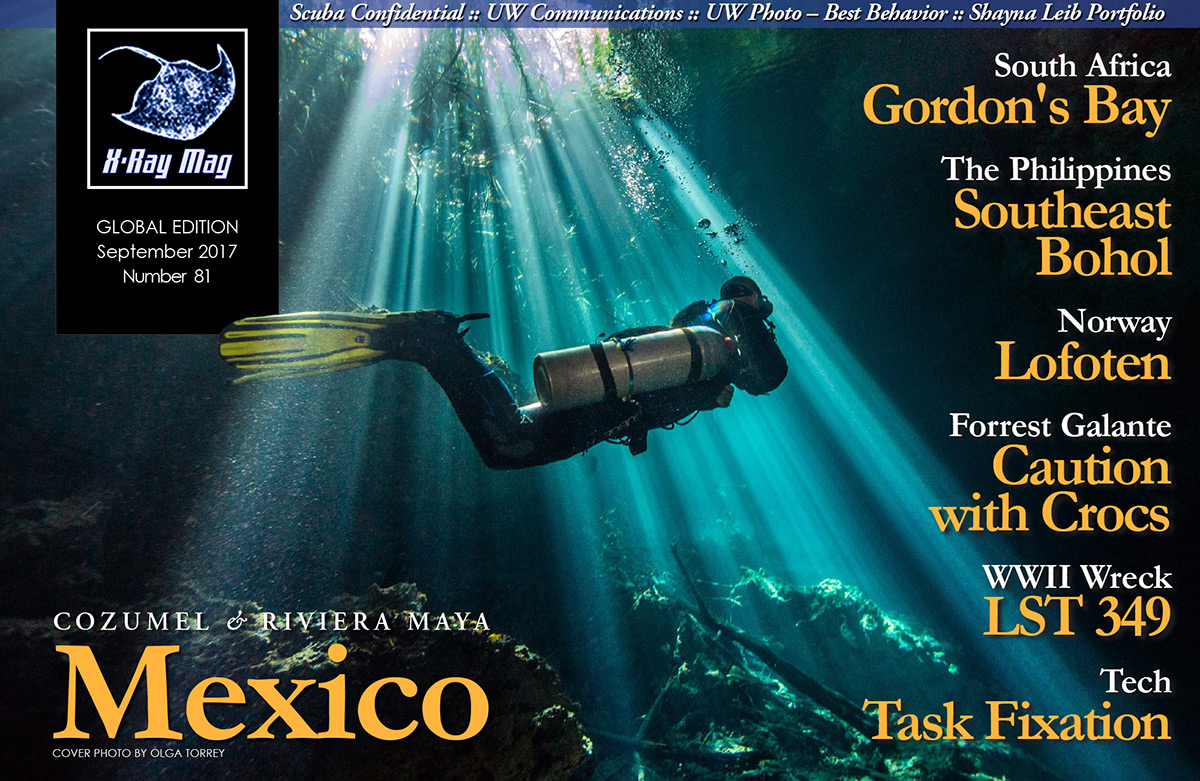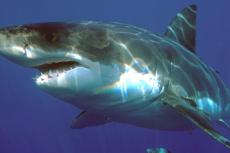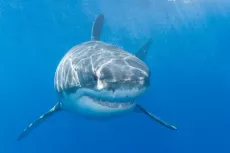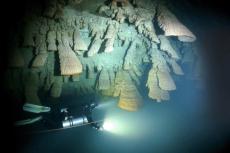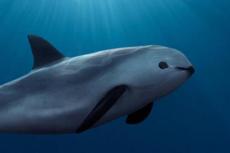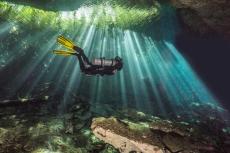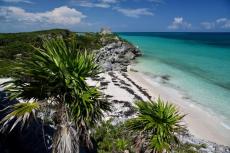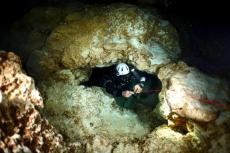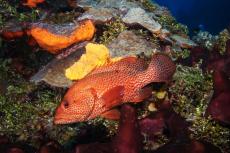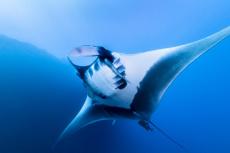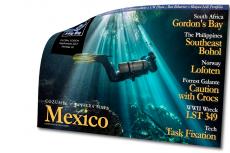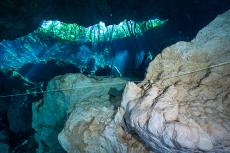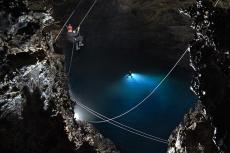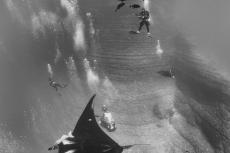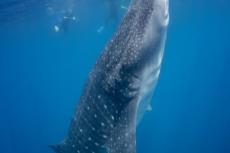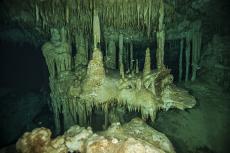Mexico has much to offer the traveling diver. The Yucatán Peninsula and Cozumel Island are close to each other and are a perfect combination for a dive trip. While Cozumel has the largest reef in the northern hemisphere, the Yucatán Peninsula has some of the best cavern and cave diving in the world, many of which are found in the Riviera Maya district located on the coast.
Contributed by
Factfile
Larry Cohen and Olga Torrey are well-traveled and published underwater photographers based in New York City, USA.
They offer underwater photography courses and presentations to dive shops, clubs and events.
For more information, visit: Liquidimagesuw.com and Liquidimagesuw.com/olga.
SOURCES:
https://www.barcelo.com/en-us/hotels/mexico/cozumel/allegro-cozumel/
https://www.barcelo.com/en-us/hotels/mexico/riviera-maya/allegro-playacar/
http://www.cozumelparks.com/eng/punta_sur.cfm
https://prodivemex.com
http://www.reefsofcozumel.com/pages/reefs/ShipwreckC53.html
http://rivieramaya.com
http://www.tulumruins.net
https://en.wikipedia.org/wiki/Cozumel
To explore both the mainland and the island, you can fly into Cancun. From there, it is a 65km (41mi) drive to Playa del Carmen. From here, you can take a 45-minute ferry over to Cozumel. At the ferry station near the bus and taxi stop, there are people with wheeled carts to help you transport your bags to and from the boat. The ferries run every hour, and it is an easy trip. There are plenty of cabs both in Playa del Carmen and Cozumel to get you to your hotel. If you are just diving Cozumel, there is an international airport on the island.
The island
Cozumel, Mexico’s largest Caribbean island, is on the other side of the Yucatán Channel, opposite Playa del Carmen. The Mayan people called the island "Ah Cuzamil Peten", which means “the island of swallows”.
There are several Mayan ruins in Cozumel. El Caracol ("the snail") is a small ruin located in the Punta Sur Eco Beach Park. This structure was dedicated to the moon goddess, Ixchel. Built between 1200 and 1400 AD, it is believed the building was used as an "alarm" for approaching hurricanes. El Caracol acted as a whistle when strong winds funneled through. The sound would warn the people to prepare for bad weather. It is also believed that the building functioned as a lighthouse or beacon used to send signals to the mainland. Some say these are just legends, and the building was a temple.
Also in the park is the Faro Celerain Lighthouse, with its charming nautical museum, and Laguna Colombia. Visitors can take a boat ride through the lagoon to observe birds and crocodiles. Many of the mangrove trees were destroyed in 2013 during Hurricanes Ingrid and Manuel, with winds up to 140km/h (87mph). They are now on their way to being restored.
Diving Cozumel
Cozumel was named by Jacques Cousteau as one of the top 10 dive spots in the world back in 1961. Most of the diving takes place in the Cozumel Reefs National Marine Park. This protected area was created in 1996. The park is home to some 26 types of corals, with more than 100 subspecies. More than 500 fish species live in the park.
Many of the dive sites are walls swept with currents that can be strong. There is drift diving here, and at times, it is difficult to stop and "smell the sponges". If you happen to be here on a full moon, the current can be even stronger. On the walls, it is possible to get to a sheltered area out of the current. On the flat reefs, divers are exposed, and it can be challenging to get out of the current to take photographs. Many photo opportunities can be missed as one drifts with the current, as a variety of marine life effortlessly swims into the current.
Dive sites
Cozumel has many different dive sites. Here are a few of the most popular ones:
Palancar Caves. Palancar Caves is a site with nice tunnel formations. This site starts on a sandbank in 12.19m (40ft) of water and is 27.43m (90ft) at the deepest. There is a steep drop-off where one may find sea turtles and nurse sharks.
Palancar Gardens. Palancar Gardens starts on a sandy patch inside the drop-off at 6m (20ft). You can then make your way through one of the canyons to around 15m (50ft) down to about 21m (70ft). There are many cuts and channels to navigate through. If you look with an attentive eye, you can find the splendid toadfish. This species is endemic to Cozumel.
Paso Del Cedral. Paso Del Cedral is a flat reef with a few swim-throughs. Here, one can observe barracuda, lobsters, moray eels, grunts, and French and queen angelfish. The site is around 15m (50ft) to 18m (60ft) deep.
Cedral Wall. Cedral Wall has some dazzling coral tunnels and mounds with numerous overhangs. One small overhang had a nurse shark and large moray eel. These two looked like best buddies and one could only guess about their relationship. Large snappers, turtles, triggerfish and spotted eagle rays could be seen swimming into the very strong current.
Punta Sur Cathedral. Punta Sur Cathedral is an impressive site with many swim-throughs. It starts at 18m (60ft), then a narrow tunnel takes you to 24m (80ft). The wall drops at a 45-degree angle down to around 40m (130ft). The chamber known as Little Cathedral has many large sponges.
Santa Rosa Reef. Santa Rosa Reef is one of Cozumel's signature dives. You start on a flat reef, then go through a tunnel to a steep wall. The coral is rocky, with large outcrops that are 10m (33ft) to 12m (40ft) tall. This is a good location to find sea turtles, barracuda and grunts.
Punta Dalila. Punta Dalila is a great site for a night dive. In only 12m (40ft) to 18m (60ft) of water, one can find octopi, lobsters, crabs and moray eels. Here, it is important to keep track of your dive buddy as the current can be strong.
Felipe Xicotencatl C-53 wreck. Felipe Xicotencatl C-53 is an artificial reef with a history. Originally a US Navy minesweeper named USS Scuffle, this ship served during WWII in the Pacific. She participated in the pre-invasion sweep of Manila Bay in preparation for landings at Mariveles and Corregidor. The USS Scuffle received five battle stars for her WWII service.
In October 1962, the ship was sold to the Mexican Navy and renamed ARM DM-05. In 1994, she was renamed again as ARM General Felipe Xicoténcatl (C53). Her time in the Mexican Navy was spent patroling the Gulf of Mexico and the Mexican Caribbean Sea for illegal arms and drugs. The ship also preformed many rescue missions.
The C-53 was decommissioned and donated to the Cozumel underwater park. She was sunk in 1999 in 25m (82ft) of water just off shore from Chankanaab Park. The ship is 56.3m (154ft) long with a 10.10m (33ft) beam and is 12m (40ft) high.
Currents can be very strong. The ship sits intact and upright. In the stern, one can still see the propeller in the sand, now covered with marine growth. The deck still has machinery and some cabins that divers can penetrate and explore. Barracuda and other marine life now call this shipwreck home.
Riviera Maya
While Cozumel Island is one of the top dive destinations in the world—with its rich, colorful reefs, walls, wreck and drop-offs—when traveling there, you should not forget about the underwater wonders to be found on the mainland along the Riviera Maya, a district that hugs the Caribbean coastline in the state of Quintana Roo.
In the north, the Riviera starts at Puerto Morelos and ends in Punta Allen. This is now a hot tourist district, but what interests many divers is underground.
This area of the Yucatán Peninsula is a porous limestone platform. Millions of years ago, this area was a reef under ocean water. During the last Ice Age, the ocean level dropped, exposing the reef to air. The coral died, and jungle grew over the mile-thick limestone platform created by the dead coral.
Cave systems were formed by the gradual dissolving of the highly porous coral limestone. These caves are called "solution" caves because they were formed by acidic rainfall dissolving the alkaline limestone. During this time, these caves were not filled with water. As a result, formations such as stalactites (which hang from the cave's ceiling) and stalagmites (which extend upwards from the cavern floor) formed. Sometimes, they joined together to create columns. When the Ice Age ended 18,000 years ago, the climate of the planet warmed up, and the caves flooded as sea levels rose.
Riviera Maya does not have any fresh water at the surface, but the area’s caves—Ox Bel Ha, Sac Aktun and Dos Ojos—are three of the longest underground freshwater systems in the world. The cave formations are frozen in time, since they cannot form underwater. These stalactites and stalagmites are a spectacular sight to see.
When a cave ceiling collapses, a cenote is formed. The word “cenote" is derived from the Mayan word “ts’onot,” which means “sacred well.” Cenotes were the only source of fresh water for the Mayan people and they considered them sacred. The Mayans considered cenotes to be an entrance to the "underworld" or "Xibalba," where their gods lived and the human spirit resided after death.
When diving here, it does feel as if you are in a different world. Diving in a cave zone where no light exists requires special training, and the cenotes are in the cavern zone. Taking a cavern course is a good idea, but these areas could be dived by all open water divers if accompanied by a properly-trained guide with an official cenote guide certification.
The visibility can be over 30m (100ft), and the water temperature is around 22-24°C (72-75°F) all year round. Besides the formations in the cenotes, another interesting phenomenon one can observe is the light. Natural sunlight filters around and through the porous ceiling, creating a magnificent light show. Rays of streaming light slice through the water, and different shapes are formed between the shadows and highlights. The effect changes, depending on how cloudy it is, the time of day and time of year.
Cenote Ponderosa. The entrance to Cenote Ponderosa is vast. The permanent gold cavern line begins a little distance in, so you, or your guide, must run a primary reel from open water to the start of the permanent gold line. A very large tunnel leads from Ponderosa over to Corral Cenote. Once you reach Corral Cenote, the cavern line follows the edge, giving you a great view of both the cavern below and jungle above. On a sunny morning, the light show is very impressive, with light streaming into the cavern.
Cenote Chac Mool. Chac Mool is lined by tree trunks and branches that reach into the water. On a sunny day, it looks like a laser show, the way the light enters the water. The light and shadows form distinct patterns on the submerged rocks. In several areas, one will encounter a strong and defined halocline. A halocline occurs when fresh water from an underground stream and saltwater seeping in from the ocean mixes. Saltwater is denser than fresh water; when they mix, one experiences an optical illusion in which everything looks blurry. I felt as if I was underwater without a mask. Swimming through a halocline is fun but can be disorienting.
Cenote Kukulkan. Cenote Kukulkan is part of the Chac Mool System. Divers can enter through an entrance down a set of steps, or one could do a short cave dive from Chac Mool to Kukulkan. At times, the open water area is covered with a green algae bloom. One can see the shadows from the trees of the jungle from underneath.
Ocean diving
Besides diving underground, Riviera Maya, which sits on the Caribbean coast, does offer ocean dives worth doing. Depending on the time of year, one can see whale sharks, sailfish and bull sharks.
Whale sharks. The whale shark season is from June to September. Boats leave from Cancun and head to Contoy Island where the whale sharks come to feed on plankton. Snorkeling with the largest fish in the world is a humbling experience.
Sailfish. Sailfish season is December through March. The boats for sailfish tours also leave from Cancun and head to Contoy Island. The sailfish are here to feed on Brazilian sardines, which form into a bait ball. First, look for the frigate birds feeding on the sardines from the surface. Once you spot them, it is time to grab your snorkeling gear and hit the water.
The sailfish use their sword-like bill to stun the sardines and feed on them. They do not use their bill to spear their prey. These fish can be as large as 3m (9.8ft) in length, and weigh up to 90kg (200lb). They typically swim at 36 km/h (22 mph) but can go as fast as 110km/h (68 mph). They are the fastest fish in the world. Snorkeling with them, as they reduce a huge bait ball down to one fish (and then no fish), is an astounding event.
While in the open ocean, it is possible to encounter manta rays, whale sharks and dolphins, but this is not an aquarium. It is also possible to spend a very long day on the boat and see only water.
Sharks. From November to March every year, a group of pregnant bull sharks migrate to the shallow waters off Playa del Carmen. They come here to give birth. It is believed that the sharks are attracted to the water’s lower salinity, caused by the underground fresh water feeding into the ocean.
The site known as Shark Point has a sandy bottom. Since these are pelagic fish, it is difficult for scientists to acquire data. Since 2010, the nonprofit organization, Saving Our Sharks, has been gathering data and identifying the different sharks that visit Playa del Carmen. Twenty-five individuals have been identified. Besides the bull sharks, remoras and other marine life can be observed.
Diverse marine life. There are many patch reefs off Playa del Carmen including Jardines and Sabalos. These reefs might not be as lush as the reefs and walls off Cozumel, but they are teeming with life. Large schools of grunts, porkfish and tangs can be observed. Different species of parrotfish and moray eels can be seen in the crevices. Skates can be seen in the sandy areas between the reef patches. The current at top of these reefs could be strong. It is possible to stay low and out of the current.
Dive center and hotel
Pro Dive International is a PADI Five Star Dive facility and Career Development Center. It runs the scuba concessions in several resorts in Cozumel, Playa del Carmen and the Dominican Republic. Their gear is in superior condition, nitrox is free and the staff is very supportive. In Cozumel, the center is set up for recreational diving and training, and advanced specialty courses are offered. Dive boats get divers to the dive sites fast due to their close proximity and the boats’ speed. The dive guides help you enjoy your dive experience whether you are a rookie or experienced diver. Pro Dive can arrange excursions to Playa del Carmen for bull shark diving, whale sharks, sailfish run and cenotes.
Allegro is one of the resorts in Cozumel and Playa del Carmen from which Pro Dive operates. In Cozumel, the sprawling grounds include five different pools, one of which is an aquatic park for children, and a hot tub area for adults. On the premises are five restaurants, five bars, spa, tennis and basketball courts and an outdoor theater. There are small bungalow-style buildings, each containing four-guest accommodations for a total of 305 rooms. The resort’s all-inclusive program includes three meals, all drinks and sits conveniently in front of Playa San Francisco, one of Cozumel’s most beautiful beaches. Besides diving, other water sports offered include windsurfing, body-boarding, sailing, snorkeling, fishing and kayaking.
This hotel takes scuba diving seriously and strives to meet the needs of traveling divers. Allegro and Pro Dive offer the VIP Ultimate Dive Experience package, which includes a one-tank dive every day and many other benefits. There is a discount for additional dives. The other convenience is that the rooms are close to the dive shop and there is a special diver lounge named after the Santa Rosa Reef. Twice a day, at no additional charge, they offer non-certified guests a chance to try out scuba diving in the pool. If guests want to proceed further, they can get certified on the premises.
The all-inclusive Allegro Playacar Resort is located inside the gated community of Playacar. The resort sits on a fine, white sandy beach. Besides diving, beach volleyball, windsurfing and other water sports are offered. This is a convenient base from which to visit the Mayan archaeological sites, as well as oceanic and cenote dive sites. Unlimited meals, snacks and beverages are available at the resort’s three restaurants and five bars. After a day of exploring, this is a welcoming way to relax.
Pro Dive International has a small check-in point at the coveted Allegro Playacar all-inclusive resort. Dive operations take place at its larger facility next door, at the luxury four diamond-rated Royal Hideaway Hotel.
The shop is right on the beach. Boats pull up to the surf zone for the reef and bull shark dives. At this location, if requested, Pro Dive provides double tanks and singles with left and right valves for sidemount. Nitrox is free and all ocean guides are fully qualified PADI Master Scuba Diver Trainers. The cavern guides are also at PADI MSDT level, and are fully certified full cave divers, with an official cenote guide certification.
Cavern training and full cave courses are offered as well, by highly qualified and experienced full cave diving instructors. Pro Dive offers cave tours to divers that are cave certified. Pro Dive has comfortable trucks to take divers to the cenotes. The staff can also arrange for vans to take you to Cancun for sailfish or whale shark expeditions. Trips to Cozumel are also offered at this location.
Mayan ruins
A visit to the Riviera Maya would not be complete without seeing one of the major Mayan archaeological sites. Tulum is the only ruin that is on the Caribbean Sea. It was previously known as Zama, meaning the "City of Dawn". The current name “Tulum” means "fence" or "trench" in Mayan. This is one of the few Mayan cities protected by a wall.
Between the 13th and 15th centuries, vanishing only 70 years after the Spanish army started conquering today’s Mexico, Tulum was a major trading center for the Mayan people. This was an important location for both land and sea routes. The population is estimated to have been between 1,000 and 1,600.
The Daily Mail reported that, nowadays, two million tourists visit Tulum each year—sometimes as many as 2,000 per day. This is more people than the estimated local population. As crowded as it can get, Tulum is still worth visiting. You will get a glimpse into the lives of the Mayan people who depended on the cenotes in which we now dive.
The ruin is enclosed with a limestone wall on three sides. It is 7m (23ft) thick, and varies between 3m (10ft) and 5m (16ft) in height. Visitors enter through one of five doorways and see some spectacular ancient buildings. Castillo (castle) is the most dramatic. It is perched on the edge of a 12m (39ft) limestone cliff. Below is a beautiful white sandy beach on the Caribbean Sea. Besides the ruins, one is almost guaranteed to encounter iguanas, white-nosed coati and other wildlife.
For the curious traveling diver, the coasts of Mexico offer a variety of dive experiences, history and culture. The sun, blue sky, new friends and well-known hospitality of Mexico will create a superb trip experience. Both the Riviera Maya and Cozumel will entice you to come back for more. ■

